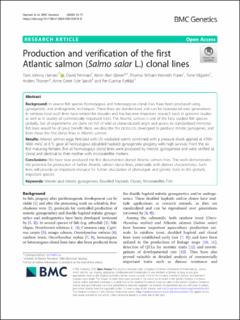Production and verification of the first Atlantic salmon (Salmo salar L.) clonal lines
| dc.contributor.author | Hansen, Tom Johnny | |
| dc.contributor.author | Penman, David J. | |
| dc.contributor.author | Glover, Kevin | |
| dc.contributor.author | Fraser, Thomas | |
| dc.contributor.author | Vågseth, Tone | |
| dc.contributor.author | Thorsen, Anders | |
| dc.contributor.author | Sørvik, Anne Grete Eide | |
| dc.contributor.author | Fjelldal, Per Gunnar | |
| dc.date.accessioned | 2020-10-15T11:46:42Z | |
| dc.date.available | 2020-10-15T11:46:42Z | |
| dc.date.created | 2020-07-24T14:52:53Z | |
| dc.date.issued | 2020 | |
| dc.identifier.citation | BMC Genetics. 2020, 21 . | en_US |
| dc.identifier.issn | 1471-2156 | |
| dc.identifier.uri | https://hdl.handle.net/11250/2683072 | |
| dc.description.abstract | In several fish species homozygous and heterozygous clonal lines have been produced using gynogenetic and androgenetic techniques. These lines are standardized and can be reproduced over generations. In rainbow trout such lines have existed for decades and has become important research tools in genome studies as well as in studies of commercially important traits. The Atlantic salmon is one of the best studied fish species globally, but all experiments are done on fish of wild or domesticated origin and access to standardized immortal fish lines would be of great benefit. Here, we describe the protocols developed to produce mitotic gynogenes, and from these the first clonal lines in Atlantic salmon. | en_US |
| dc.language.iso | eng | en_US |
| dc.title | Production and verification of the first Atlantic salmon (Salmo salar L.) clonal lines | en_US |
| dc.type | Peer reviewed | en_US |
| dc.type | Journal article | en_US |
| dc.description.version | publishedVersion | en_US |
| dc.source.pagenumber | 0 | en_US |
| dc.source.volume | 21 | en_US |
| dc.source.journal | BMC Genetics | en_US |
| dc.identifier.doi | 10.1186/s12863-020-00878-8 | |
| dc.identifier.cristin | 1820452 | |
| cristin.ispublished | true | |
| cristin.fulltext | original | |
| cristin.qualitycode | 1 |
Tilhørende fil(er)
Denne innførselen finnes i følgende samling(er)
-
Articles [3012]
-
Publikasjoner fra CRIStin [3070]
